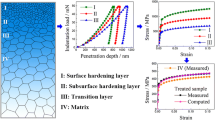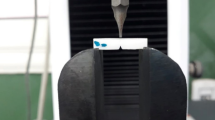Abstract
Highly dense zirconia dental ceramic coatings were fabricated by aqueous electrophoretic deposition (EPD) and subsequently sintered between 1250 and 1450 °C. Microstructural examination revealed that aqueous EPDZrO2 coatings possessed a tetragonal phase structure and the grain size increased with increasing sintering temperature. Nanoindentation study proved that the aqueous EPDZrO2 coating also had excellent mechanical properties. The effect of different applied loads on hardness and elastic modulus of the 1350 °C-sintered sample at room temperature was investigated by the method of progressive multicycle measurement nanoindentation. The simulative experiment proved that hardness of aqueous EPDZrO2 exhibited reverse indentation size effect (ISE) behavior and then displayed the normal ISE response. The analysis indicates that the reverse ISE is attributed to the relaxation of surface stresses resulting from indentation cracks at small loads and normal ISE is caused by geometrically necessary dislocations. The tetragonal—monoclinic stress-induced phase transformation during nanoindentation is the primary cause of dental zirconia failures.






Similar content being viewed by others
References
Y. Zhu, R. Zhu, J. Ma, Z. Weng, Y. Wang, X. Shi, Y. Li, X. Yan, Z. Dong, J. Xu, C. Tang, and L. Jin: In vitro cell proliferation evaluation of porous nano-zirconia scaffolds with different porosity for bone tissue engineering. Biomed. Mater. 10, 055009 (2015).
G.M. Tartaglia, E. Sidoti, and C. Sforza: Seven-year prospective clinical study on zirconia-based single crowns and fixed dental prostheses. Clin. Oral Invest. 19, 1137 (2015).
Q.N. Sonza, A. Della Bona, and M. Borba: Effect of the infrastructure material on the failure behavior of prosthetic crowns. Dent. Mater. 30, 578 (2014).
M-S. Kwon, S-Y. Oh, and S-A. Cho: Two-body wear comparison of zirconia crown, gold crown, and enamel against zirconia. J. Mech. Behav. Biomed. Mater. 47, 21 (2015).
A.R. Alao and L. Yin: Nano-scale mechanical properties and behavior of pre-sintered zirconia. J. Mech. Behav. Biomed. Mater. 36, 21 (2014).
M. Ferrari, A. Vichi, and F. Zarone: Zirconia abutments and restorations: From laboratory to clinical investigations. Dent. Mater. 31, e63 (2015).
M. Ozcan and M. Bernasconi: Adhesion to zirconia used for dental restorations: A systematic review and meta-analysis. J. Adhes. Dent. 17, 7 (2015).
N.R.F.A. Silva, I. Sailer, Y. Zhang, P.G. Coelho, P.C. Guess, A. Zembic, and R.J. Kohal: Performance of zirconia for dental healthcare. Materials 3, 863 (2010).
J.G. Wittneben, R.F. Wright, H.P. Weber, and G.O. Gallucci: A systematic review of the clinical performance of CAD/CAM single-tooth restorations. Int. J. Prosthod. 22, 466 (2009).
S.B. Patzelt, B.C. Spies, and R.J. Kohal: CAD/CAM-fabricated implant-supported restorations: A systematic review. Clin. Oral Implants Res. 26 (Suppl. 11), 77 (2015).
I. Denry and J.R. Kelly: State of the art of zirconia for dental applications. Dent. Mater. 24, 299 (2008).
P.F. Manicone, P. Rossi Iommetti, and L. Raffaelli: An overview of zirconia ceramics: Basic properties and clinical applications. J. Dent. 35, 819 (2007).
T. Nakamura, H. Nishida, T. Sekino, M. Nawa, K. Wakabayashi, S. Kinuta, Y. Mutobe, and H. Yatani: Electrophoretic deposition zirconia/alumina of ceria-stabilized zironia/alumina powder. Dent. Mater. J. 26, 623 (2007).
K. Raju and D.H. Yoon: Electrophoretic deposition of BaTiO3 in an aqueous suspension using asymmetric alternating current. Mater. Lett. 110, 188 (2013).
D.H. Yoon, Muksin, and K. Raju: Alternating current electrophoretic deposition (AC-EPD) of SiC nanoparticles in an aqueous suspension for the fabrication of SiCf/SiC composites. Dig. J. Nanomater. Bios. 10, 1103 (2015).
A. Chávez-Valdez and A.R. Boccaccini: Innovations in electrophoretic deposition: Alternating current and pulsed direct current methods. Electrochim. Acta 65, 70 (2012).
L. Besra and M. Liu: A review on fundamentals and applications of electrophoretic deposition (EPD). Prog. Mater. Sci. 52, 1 (2007).
K. Raju, H-W. Yu, and D-H. Yoon: Aqueous electrophoretic deposition of SiC using asymmetric AC electric fields. Ceram. Int. 40, 12609 (2014).
A. Chavez-Valdez, M. Herrmann, and A.R. Boccaccini: Alternating current electrophoretic deposition (EPD) of TiO2 nanoparticles in aqueous suspensions. J. Colloid Interface Sci. 375, 102 (2012).
M. Ammam: Electrophoretic deposition under modulated electric fields: A review. RSC Adv. 2, 7633 (2012).
M. Majic Renjo, L. Curkovic, S. Stefancic, and D. Coric: Indentation size effect of Y-TZP dental ceramics. Dent. Mater. 30, e371 (2014).
E.K. Mahoney, R. Rohanizadeh, F.S. Ismail, N.M. Kilpatrick, and M.V. Swain: Mechanical properties and microstructure of hypomineralised enamel of permanent teeth. Biomaterials 25, 5091 (2004).
E. Mahoney, A. Holt, M. Swain, and N. Kilpatrick: The hardness and modulus of elasticity of primary molar teeth:an ultra-micro-indentation study. J. Dent. 28, 589 (2000).
L. Angker and M.V. Swain: Nanoindentation: Application to dental hard tissue investigations. J. Mater. Res. 21, 1893 (2011).
A. Apratim, P. Eachempati, K.K. Krishnappa Salian, V. Singh, S. Chhabra, and S. Shah: Zirconia in dental implantology: A review. J. Int. Soc. Prev. Community Dent. 5, 147 (2015).
S. Stemmer, J. Vleugels, and O. Van Der Biest: Grain boundary segregation in high-purity, yttria-stabilized tetragonal zirconia polycrystals (Y-TZP). J. Eur. Ceram. Soc. 18, 1565 (1998).
M.L. Mecartney: Influence of an amorphous second phase on the properties of yttria-stabilized tetragonal zirconia polycrystals (Y-TZP). J. Am. Ceram. Soc. 70, 54 (1987).
L. Besra, T. Uchikoshi, T.S. Suzuki, and Y. Sakka: Bubble-free aqueous electrophoretic deposition (EPD) by pulse-potential application. J. Am. Ceram. Soc. 91, 3154 (2008).
A.R. Alao and L. Yin: Loading rate effect on the mechanical behavior of zirconia in nanoindentation. Mater. Sci. Eng., A 619, 247 (2014).
L. Shao, D. Jiang, and J. Gong: Nanoindentation characterization of the hardness of zirconia dental ceramics. Adv. Eng. Mater. 15, 704 (2013).
M. Guazzato, M. Albakry, S.P. Ringer, and M.V. Swain: Strength, fracture toughness and microstructure of a selection of all-ceramic materials. Part II. Zirconia-based dental ceramics. Dent. Mater. 20, 449 (2004).
Z.H. Cao, H.M. Lu, X.K. Meng, and A.H.W. Ngan: Indentation size dependent plastic deformation of nanocrystalline and ultrafine grain Cu films at nanoscale. J. Appl. Phys. 105, 083521 (2009).
G. Xiao, G. Yuan, C. Jia, X. Yang, Z. Li, and X. Shu: Strain rate sensitivity of Sn–3.0Ag–0.5Cu solder investigated by nanoindentation. Mater. Sci. Eng., A 613, 336 (2014).
T. Ebisu and S. Horibe: Analysis of the indentation size effect in brittle materials from nanoindentation load—displacement curve. J. Eur. Ceram. Soc. 30, 2419 (2010).
J.M. Luo, C.Y. Dai, Y.G. Shen, and W.G. Mao: Elasto-plastic characteristics and mechanical properties of as-sprayed 8 mol% yttria-stabilized zirconia coating under nano-scales measured by nanoindentation. Appl. Surf. Sci. 309, 271 (2014).
T. Zhu, A. Bushby, and D. Dunstan: Size effect in the initiation of plasticity for ceramics in nanoindentation. J. Mech. Phys. Solids 56, 1170 (2008).
X.J. Ren, R.M. Hooper, C. Griffiths, and J.L. Henshall: Indentation size effect in ceramics: Correlation with H/E. J. Mater. Sci. Lett. 22, 1105 (2003).
T.F. Page, W.C. Oliver, and C.J. McHargue: The deformation behavior of ceramic crystals subjected to very low load (nano)indentations. J. Mater. Res. 7, 450 (2011).
H. Li and R.C. Bradt: The effect of indentation-induced cracking on the apparent microhardness. J. Mater. Sci. 31, 1065 (1996).
K. Sangwal: Review: Indentation size effect, indentation cracks and microhardness measurement of brittle crystalline solids-some basic concepts and trends. Cryst. Res. Technol. 44, 1019 (2009).
K. Sangwal and B. Surowska: Study of indentation size effect and microhardness of SrLaAlO4 and SrLaGaO4 single crystals. Mater. Res. Innovations 7, 91 (2016).
K. Sangwal and A. Kłos: Study of microindentation hardness of different planes of gadolinium calcium oxyborate single crystals. Cryst. Res. Technol. 40, 429 (2005).
S. Sebastian and M.A. Khadar: Microhardness indentation size effect studies in 60B2O3-(40-x) PbO-xMCl2 and 50B2O3(50-x) PbO-xMCl2 (M = Pb, Cd) glasses. J. Mater. Sci. 40, 1655 (2005).
S.J. Bull: On the origins and mechanisms of the indentation size effect. Z. Metallkd. 94, 787 (2003).
K. Sangwal: On the reverse indentation size effect and microhardness measurement of solids. Mater. Chem. Phys. 63, 145 (2000).
N.A. Fleck, G.M. Muller, M.F. Ashby, and J.W. Hutchinson: Strain gradient plasticity: Theory and experiment. Acta Metall. Mater. 42, 475 (1994).
A.A. Elmustafa, J.A. Eastman, M.N. Rittner, J.R. Weertman, and D.S. Stone: Indentation size effect: Large grained aluminum versus nanocrystalline aluminum-zirconium alloys. Scr. Mater. 43, 951 (2000).
E.Q. Liu, H.F. Wang, G.S. Xiao, G.Z. Yuan, and X.F. Shu: Creep-related micromechanical behavior of zirconia-based ceramics investigated by nanoindentation. Ceram. Int. 41, 12939 (2015).
L. Jin: Property study of nano-zirconia formed by aqueous electrophoretic deposition. In General Session & Exhibition of the IADR/AADR/CADR No.89 (Sage Publications, San Diego, 2011).
K.L. Johnson: Contact Mechanics (Cambridge University Press, 1996).
W.C. Oliver and G.M. Pharr: Measurement of hardness and elastic modulus by instrumented indentation: Advances in understanding and refinements to methodology. J. Mater. Res. 19, 3 (2011).
I.N. Sneddon: The relation between load and penetration in the axisymmetric boussinesq problem for a punch of arbitrary profile. Int. J. Eng. Sci. 3, 47 (1965).
G.M. Pharr, W.C. Oliver, and F.R. Brotzen: On the generality of the relationship among contact stiffness, contact area, and elastic modulus during indentation. J. Mater. Res. 7, 613 (2011).
X. Li and B. Bhushan: A review of nanoindentation continuous stiffness measurement technique and its applications. Mater. Charact. 48, 11 (2002).
Acknowledgment
This work was supported by the National Natural Science Foundation of China (51501074), China Postdoctoral Science Foundation (2016M602983), and Postdoctoral Science Foundation of Jiangsu (1601047A). The authors also thank Dr. I. Asempah for his valuable help in improving the language of the manuscript.
Author information
Authors and Affiliations
Corresponding authors
Rights and permissions
About this article
Cite this article
Wang, L., Asempah, I., Li, X. et al. Indentation size effect in aqueous electrophoretic deposition zirconia dental ceramic. Journal of Materials Research 34, 555–562 (2019). https://doi.org/10.1557/jmr.2018.464
Received:
Accepted:
Published:
Issue Date:
DOI: https://doi.org/10.1557/jmr.2018.464




